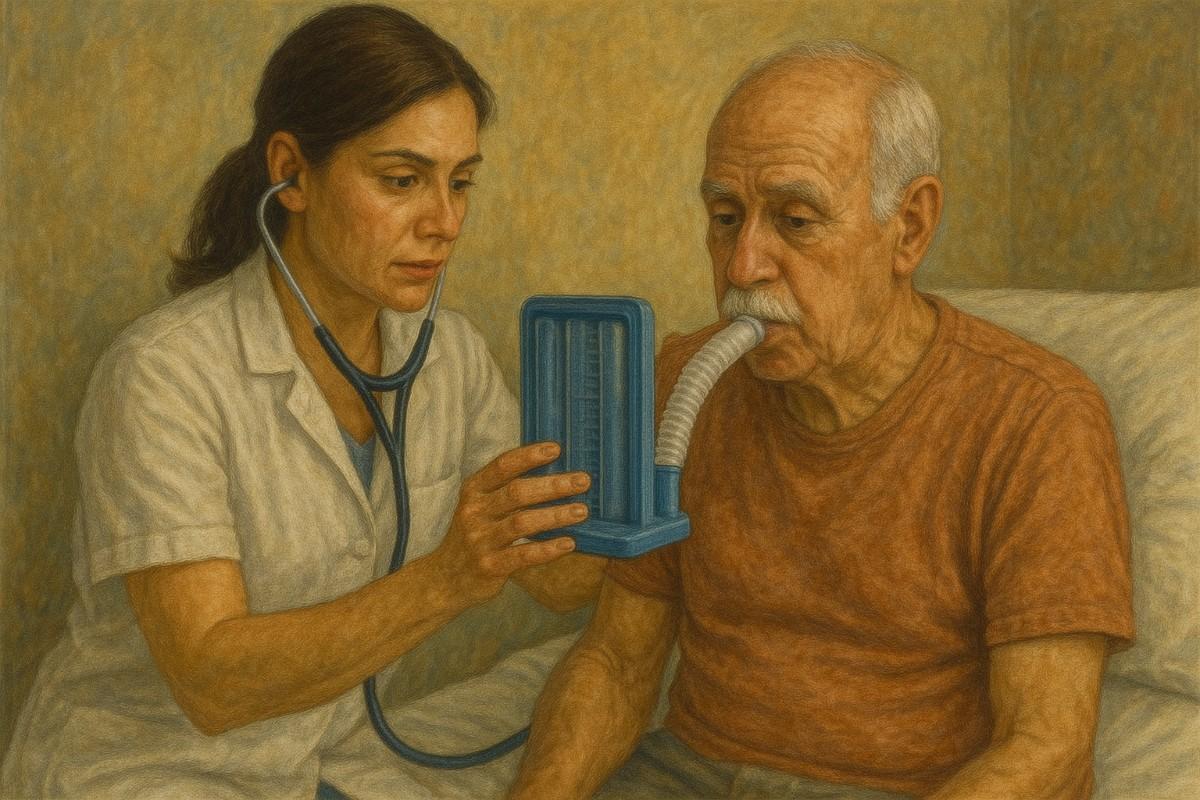Cardiorespiratory physiotherapy represents a specialized physiotherapy area that concentrates on preventing and rehabilitating patients with both acute and chronic heart and lung diseases as well as managing their ongoing care. The practice supports cardiovascular and lung function enhancement while increasing exercise performance and functional autonomy to boost patients’ total quality of life.
The cardiorespiratory system functions to deliver oxygen throughout the body while eliminating carbon dioxide. Physical capacity becomes severely restricted and life expectancy decreases when the cardiorespiratory system faces complications from illness or surgery, trauma or congenital problems. Through evidencebased practices physiotherapists implement breathing exercises, aerobic conditioning exercises, chest physiotherapy techniques and educational sessions to manage these health issues.
Cardiorespiratory physiotherapy serves as a fundamental element of treatment in hospital settings and medical offices. The application of cardiorespiratory physiotherapy proves vital within intensive care units (ICUs), rehabilitation centers, cardiac care units, and community health programs.
Goals of Cardiorespiratory Physiotherapy
The main purpose of cardiorespiratory physiotherapy is to enhance both cardiopulmonary health and physical function through multiple specific goals.
1. Improve Airway Clearance
Excessive mucus production in patients with respiratory diseases causes airway blockages while increasing the risk of infections. Percussion therapy together with postural drainage, active cycle of breathing techniques (ACBT), and positive expiratory pressure (PEP) therapy work to clear lung secretions and improve ventilation within the lungs.
2. Enhance Lung Expansion
Lung capacity decreases when patients experience conditions like pneumonia, postoperative atelectasis, or restrictive lung diseases. To enhance respiratory function and prevent health complications therapists implement incentive spirometry, deep breathing exercises, and thoracic expansion techniques.
3. Improve Exercise Tolerance
People with cardiopulmonary disorders experience decreased stamina and fatigue earlier during activities. Through a customized aerobic exercise routine patients benefit from better muscle oxygenation while cardiovascular endurance improves and daily activities become easier to perform without quick exhaustion.
4. Prevent PostOperative Complications
Patients who undergo thoracic or abdominal surgeries face complications risks including atelectasis, deep vein thrombosis (DVT), and pulmonary embolism. These risks decrease when patients begin early mobilization as well as use breathing techniques and circulationenhancing exercises.
5. Promote Functional Independence
Patients who undergo gradual training and conditioning learn to perform everyday tasks like walking and household chores which helps them achieve both independence and selfconfidence.
6. Reduce Breathlessness (Dyspnea)
Patients with chronic lung diseases such as COPD experience debilitating breathlessness. Techniques like pursedlip breathing and diaphragmatic breathing alongside energy conservation methods decrease breathing effort which enhances patient comfort.
7. Educate and Empower Patients
Patient education is central to CRP. Therapists provide training to individuals on how to handle their health conditions and demonstrate proper use of inhalers while teaching them to spot early warning signs and adhere to lifestyle changes including quitting smoking and improving their diet.
Common Conditions Treated
Cardiorespiratory physiotherapists treat multiple disorders that impact both cardiac and pulmonary systems. These include:
Respiratory Conditions
Chronic Obstructive Pulmonary Disease (COPD)
Asthma
Bronchiectasis
Cystic Fibrosis
Pulmonary Fibrosis
Pneumonia
PostCOVID respiratory impairment
Postsurgical lung complications (e.g., thoracotomy, lobectomy)
Mechanical ventilation weaning support
Cardiac Conditions
Coronary Artery Disease (CAD)
PostMyocardial Infarction (Heart Attack)
Congestive Heart Failure (CHF)
PostCardiac Surgery Rehabilitation (CABG, valve repair)
Hypertensionrelated complications
Cardiomyopathies
Scope of Cardiorespiratory Physiotherapy
Cardiorespiratory physiotherapy covers extensive areas that include clinical practice, preventive measures, educational activities, and research initiatives.
1. Acute Care and Intensive Care Units (ICUs)
ICU physiotherapists take care of ventilated patients and those with multiorgan dysfunction and surgical recovery patients. Their roles include:
Airway clearance
Lung reexpansion
Positioning to enhance ventilation/perfusion
Early mobilization to prevent ICUacquired weakness
2. PostSurgical Rehabilitation
The application of CRP helps patients who are recovering from openheart surgeries as well as those who have undergone lung resections or abdominal operations.
Prevent pulmonary complications
Improve breathing mechanics
Encourage ambulation
Train in breathing techniques and cough effectiveness
3. Pulmonary Rehabilitation Programs
Structured outpatient programs include:
Aerobic and resistance training
Breathing exercises
Education sessions
Psychosocial support
These programs deliver significant results for patients suffering from COPD and interstitial lung diseases as well as those with chronic asthma conditions.
4. Cardiac Rehabilitation
This multistep program supports both physical and emotional recovery alongside lifestyle changes for patients who have undergone cardiac events including:
Heart attack
Heart failure exacerbation
Cardiac surgery
The program includes:
Baseline cardiac assessment
Graded aerobic training (e.g., treadmill, cycle ergometer)
Heart rate monitoring and exercise prescription
Risk factor modification (smoking, diet, stress)
5. Community Health and Home Care
Homebound patients as well as elderly and those recovering from extended stays in hospitals need CRP for optimal care. Services include:
Monitoring oxygen saturation
Teaching safe exercises
Home oxygen training
Fall risk reduction in cardiopulmonarycompromised individuals
6. Pediatrics and Neonatal Units
Kids suffering from cystic fibrosis or congenital heart disease require specialized physiotherapy to help improve their lung functionality and motor development.
7. Preventive and Lifestyle Medicine
Physical therapists specialized in cardiopulmonary rehabilitation promote preventive healthcare through their initiatives.
Physical activity in sedentary individuals
Smoking cessation
Weight management
Cardiopulmonary fitness enhancement in highrisk populations
8. Research and Education
As evidence develops in respiratory muscle training and telerehabilitation combined with home spirometry CRP physiotherapists hold essential roles at academic institutions and research facilities where they support evidencebased practices and educate upcoming practitioners.
Modern Tools and Techniques in CRP
Technological progress has broadened the scope of CRP practices. Tools and modalities include:
Incentive Spirometer
NonInvasive Ventilation (NIV) Training
Positive Expiratory Pressure (PEP) Devices
Oscillatory Devices (e.g., Acapella, Flutter)
Pulse Oximetry
Telerehabilitation platforms
Cardiopulmonary Exercise Testing (CPET)
Robotics and VR for aerobic training
The tools serve multiple functions including assessment procedures and customized interventions while monitoring patient progress.
Interdisciplinary Collaboration
A multidisciplinary team approach enhances the effectiveness of cardiorespiratory physiotherapy because it enables collaboration with various health professionals.
Pulmonologists and cardiologists
Respiratory therapists
Dietitians
Occupational therapists
Nurses
Psychologists
The approach delivers comprehensive patientfocused care for both urgent and ongoing heart and lung health issues.
Cardiorespiratory physiotherapy plays a critical role within today’s healthcare framework by providing prevention services and acute management support alongside longterm rehabilitation for heart and lung conditions. By applying evidencegrounded methods alongside patientcentered strategies CRP therapists enable patients to recover strength and breathing ability while extending their lifespan.
The increasing global incidence of cardiovascular and respiratory diseases driven by aging populations and other factors creates a rising need for expert cardiorespiratory physiotherapists. These professionals save lives while enabling patients to experience complete and fulfilling lives.
– Dr. Vaibhav Dave, Head of Department
Department of Physiotherapy, Madhav University

